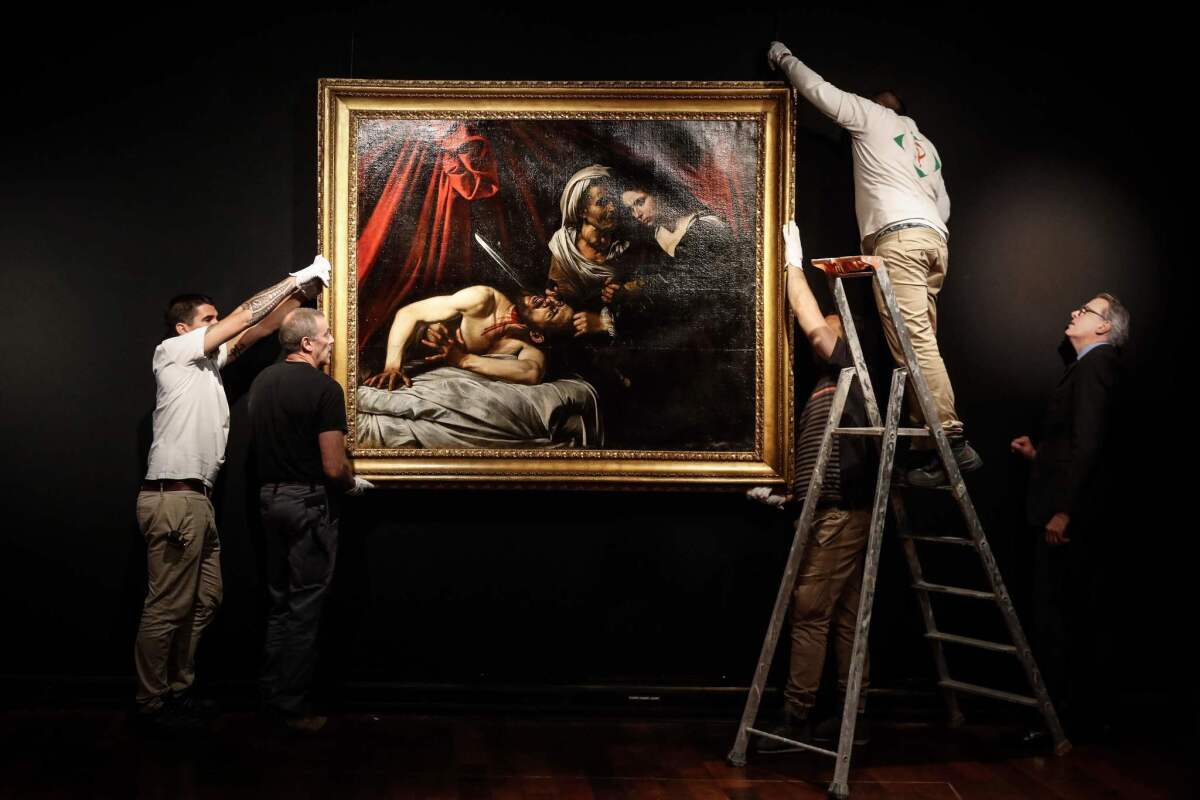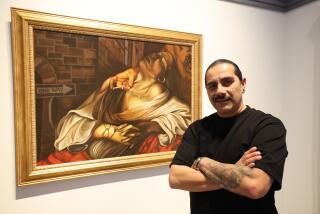Surprise twist for Caravaggio painting valued at $100-million-plus: A mystery buyer

They came to auctioneer Marc Labarbe’s studio last week to stand mere inches from the painting of Jewish heroine Judith decapitating Assyrian general Holofernes, a dazzling yet bloody masterpiece attributed to Italian painter Caravaggio.
But locals, art aficionados and the plain curious have been just as mesmerized by the painting’s back story, the tale of an unlikely discovery in a local attic in 2014 and a journey that was to end Thursday with an auction. “Judith and Holofernes” was estimated to fetch bids of $115 million to $170 million, but the story took yet another turn Tuesday when a mystery buyer stepped forward and bought the painting before the auction could take place.
Labarbe’s company’s announced on its Facebook page that the sales price and identity of the buyer were protected by a confidentiality agreement, but he did confirm that the painting “will leave the French soil.”
For the last five years, residents of this southern city have been captivated by the Caravaggio, as it is simply called, whose owners have added to the sense of mystery by remaining steadfastly anonymous. With ancient homes and apartments often stuffed with old neglected paintings and furniture handed down through generations, the Toulouse Caravaggio has left residents fantasizing about what might be lurking in their own attics.
“It’s so intriguing,” Laurent Sobanski said as he leaned in for a closer look during a recent public preview. “It’s not every day one finds a treasure like this in the attic. It was unnoticed for so long and remained in such good condition. It seems so improbable.”
Perhaps no one grasps the unlikelihood better than auctioneer Labarbe, who helped to shepherd the painting through a tortuous path of authentication, convincing some but not all skeptics. The hefty valuation, the story of its finding and the enigmatic life of Caravaggio made for a potent combination that guaranteed the auction focused international attention on a city far from the art world’s capitals.
“This story is beautiful, and this story makes us dream,” Labarbe said. “But what really makes us dream is the painting. It really is a wonder. We are very lucky.”
Before the Caravaggio entered his life, Labarbe had already carved out a successful career. He had a taste of international notoriety when he led an auction of components from the old Concorde supersonic jetliners back in 2007. Later he sold a client’s ancient Chinese scroll for 22 million euros, about $25 million at current exchange rates. But much of the auctioneer’s job is fielding queries from people wondering if some bric-a-brac might have something more than sentimental value.
Period furniture, old baubles or minor artworks typically are destined for sales at garage sales called vide-greniers (empty attics) held across France. In this case, Labarbe already had worked with the clients in question to sell minor items uncovered in the old house that had been in their family for decades.
So when they called again to say they had found yet another painting in the attic, Labarbe postponed a visit several times before finally finding time on April 23, 2014, to examine the artwork. Family members were considering renovating the attic, which prompted them to empty it. The space was stuffed with toys, clothes, old furniture and other accumulated possessions. Some had been damaged by the leaky roof. Other items had been stolen years earlier by thieves who probably regret what could have been.
Upon moving a mattress leaning against a wall, the family saw the painting.
By the time Labarbe arrived, they had placed it in a hallway, the canvas slightly more than 68 inches across and 56 inches high and covered with grime. Wiping it clean with a cotton cloth revealed just enough of the imagery to convince Labarbe that it was a remarkable work, certainly not destined for a yard sale.
Thinking that it might well be of an Italian school of painting from the 17th century, he contacted a Paris-based auctioneer, Eric Turquin, who specialized in Old Masters. The painting was shipped to Paris, where after three months of study and research, Turquin and his team came to a conclusion about the unsigned work that exceeded Labarbe’s grandest hopes: It was a Caravaggio.
Michelangelo Merisi da Caravaggio was a passionate, sometimes violent, artist who developed a style that blended intense emotion and realism. Though well-known during his time, he died in 1610 at the age of 38, and he was largely forgotten or dismissed.
By the time his reputation was rehabilitated by critics last century, a fair number of his works had simply slipped into obscurity, likely considered not valuable or noteworthy by those who bought and sold them over the centuries. In recent decades, paintings possibly by Caravaggio have been “found” every few years and can pass through years of debate and controversy before being accepted.
The Toulouse Caravaggio was no different. The painting depicts a Biblical scene in which Judith, having seduced the invading general Holofernes and gotten him drunk, cuts his throat to save her people. The episode has been a popular image for artists across the centuries.

Indeed, there is another Caravaggio painting of Judith and Holofernes that he made around 1600 and that hangs in the Galleria Nazionale d’Arte Antica in Rome. That one emphasizes the first cut of the blade and the surprised look on the general’s face. A well-known version by Caravaggio’s contemporary Louis Finson hangs in the Intesa Sanpaolo Bank in Naples and has long been assumed to be a copy of a lost Caravaggio.
This Finson painting turns the attention to Judith, who appears to be striking the final blow to sever the head — the image of the Toulouse Caravaggio. Indeed, several art experts initially told Labarbe and Turquin that the Toulouse painting was likely by Finson, leaving the Toulouse auctioneer deflated.
Eventually, however, opinion turned in their favor. X-ray and other scientific analysis of the canvas supported the idea the Toulouse painting was the original Caravaggio that Finson had copied.
Between November 2016 and February 2017, the Pinacoteca di Brera museum in Milan organized an exhibition called “A Question of Attribution” and hung the Finson and Toulouse paintings next to each other. At the end of the show, Caravaggio experts debated the question. In a report on the meeting, Keith Christiansen, the chairman of European paintings at the Metropolitan Museum of Art in New York, wrote that despite some dissent, the group largely believed the Toulouse painting was a Caravaggio, possibly with some finishing touches by a second artist.
“It was generally conceded that, regardless of attribution, this is a very major work of art, indeed, and one fully worthy of the controversy it has inspired,” Christiansen wrote.
As the art world debated, there remained the question of how such a painting could have landed in Toulouse. To help solve that riddle, Labarbe turned to Véronique Castagné, a Toulouse art historian who set about rummaging through archives to find answers.
Castagné found that centuries ago, when Toulouse was one of the most prosperous cities in France, strong ties developed between local Catholic leaders and Italy, including some connections with Caravaggio. Later, the city became a center of art collectors, and records show at least three other Caravaggio paintings passing through the hands of local collectors.
“There is a good chance that the painting ‘Judith and Holofernes’ by Michelangelo of Caravaggio could have returned to Toulouse in the most natural way possible,” given the large number of influential people close to royalty or highly placed lovers of art in the city, Castagné said.
Following the French Revolution, the records become even more chaotic. The Caravaggio’s former owners traced its heritage back to a soldier who served in Napoleon’s army. Exactly how it found its way to that attic remains a mystery. But throughout, the family has insisted on remaining anonymous to protect their children and avoid publicity, Labarbe said.
Standing on a raised lectern behind the Caravaggio, Labarbe recounted this history to about 200 guests who had come to his studio in an event organized by the Franco-Italian Business Club. Though not an art historian, he had become deeply knowledgeable about the work’s tiniest details — the type of earrings worn by Judith, the transparency of the lace on her sleeve, the flow of a red curtain.
“I am not an expert,” he said. “But we can know it is a Caravaggio by the passion we see.”
After the presentation, Labarbe was smiling, serving Champagne to the crowd. As the guests mingled, they were buzzing from the tale. One woman called it a “magic discovery.” Another guest said it felt like a detective novel, or something taken from an episode of “CSI” (or “Les Experts,” as it’s called in France).

For Jean-Claude Dardelet, vice president of Toulouse, the return of the Caravaggio and the decision to hold the auction here, if only for a moment, turned the art world’s attention to France’s fourth-largest city, which even in this country is known best as the headquarters of aerospace giant Airbus.
“Toulouse is famous for its planes and satellites,” he said. “People forget that Toulouse has this great history of art and culture. This is another marker that shows the artistic capacity of this city.”
For Labarbe, the planned auction in Toulouse was a way to share this moment of triumph with the city.
“I was with an American film actor in New York who wanted to know if I was going to sell it at Sotheby’s or Christie’s,” Labarbe said. “I said no, I am going to sell in Toulouse. And he said, ‘You’re kidding me!’ But me, I live in Toulouse, not London and not New York. I really wanted to create an event in my city.”
In recent months, Labarbe had been taking the painting to New York and London, where it was exhibited in hopes of seducing potential buyers.
Labarbe seemed to have trouble believing the unlikelihood of everything that has unfolded. He keeps the photos from that April day five years ago on his phone, a little reminder that this all really happened.
“I never imagined that I was there with a Caravaggio,” he said. “I am never going to erase those photos. We often take photos that we erase. But these, they take me back to that moment. So I will never erase them.”
O’Brien is a special correspondent.
LACMA DESIGN: Why the plan for chic concrete walls comes with consequences »
More to Read
Start your day right
Sign up for Essential California for news, features and recommendations from the L.A. Times and beyond in your inbox six days a week.
You may occasionally receive promotional content from the Los Angeles Times.







